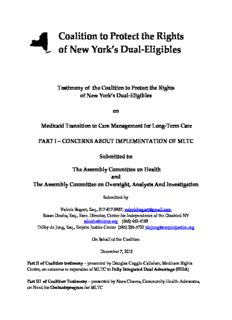
Coalition to Protect the Rights of New York's Dual-Eligibles PDF
Preview Coalition to Protect the Rights of New York's Dual-Eligibles
Coalition to Protect the Rights of New York’s Dual-Eligibles Testimony of the Coalition to Protect the Rights of New York’s Dual-Eligibles on Medicaid Transition to Care Management for Long-Term Care PART I – CONCERNS ABOUT IMPLEMENTATION OF MLTC Submitted to: The Assembly Committee on Health and The Assembly Committee on Oversight, Analysis And Investigation Submittedby ValerieBogart,Esq.,917-817-9837,[email protected] SusanDooha,Esq.,Exec.Director,CenterforIndependenceoftheDisabledNY [email protected] (646)442-4163 TrilbydeJung,Esq.,EmpireJusticeCenter (585)[email protected] OnBehalfoftheCoalition December7,2012 PartIIofCoalitiontestimony–presentedbyDouglasCoggin-Callahan,MedicareRights Center,onconcernsreexpansionofMLTCtoFullyIntegratedDualAdvantage(FIDA) PartIII ofCoalitionTestimony–presentedbyNoraChaves,CommunityHealthAdvocates, onNeedforOmbudsprogramforMLTC TheCoalitiontoProtecttheRightsofNewYork’sDualEligibles isacoalitionofdisability rightsandseniorsrightsadvocates,consumers,communityadvocacyorganizations,and lawyersrepresentingpeoplewithdisabilitiesandolderNewYorkers. We providethis testimonytoexpressconcernsabouttheimplementationofthe1115waiverinNewYorkState toincludemandatoryenrollmentofDualEligibleswhoreceiveMedicaidpersonalcareand othercommunity-basedlong-termservicesinManagedLongTermCare(“MLTC”)plans. TheMLTCplans,providers,andconsumersallwantasystemthatachievesthecommongoalof providingadequateandnecessaryservicestoenablepeopletoliveinthecommunity,in furtheranceofthegoalsoftheADAandOlmstead. However,theStateisrushinginto implementingamonumentalchangeinhowatleast85,000individualsnowreceiveMedicaid community-basedservicesinNewYorkCity,tobefollowedlaterstatewide,withoutsufficient safeguardstoensurethatenrolleeswillreceivetheservicestheyneedinthecommunityto avoidinstitutionalization. Weareparticularlytroubledbyanticipatedproblemswithcapacity, enrollment,gapsandinterruptionsincoverage,aswellaswiththeprogram’slackofproper incentives,dueprocessprotections,oversight,andabilitytoabsorbspecialprogramscurrently providingcriticallyimportantservices. Ourconcernsandourrecommendationsaresetforthin detailbelow. 1. TimingandCapacity--Mandatoryenrollmentshouldbesloweddownuntil systemic concernsdescribedbelowareaddressed,andthensolelywithnewapplicants-- over1,000 personspermonthinNYCalone,whichwouldprovideanopportunitytoworkoutandtestthe newsystems.Auto-assignmentandmandatoryenrollmentofcurrentpersonalcare recipients shouldbesuspendedforatleastsixmonths,toallowtheState,inconsultationwith stakeholders,tomonitortheimpactofmandatoryenrollmentuponnewapplicantsandadjust thecapitationratesandothersystemsasnecessary. Evenwithlessthan1000peopleauto-assigned–thefirstinNovember2012--enrollmentin MLTCplansinNYChasskyrocketed,duetomarketingbyplansandinresponsetoMaximus’ letterssenttoover10,000currentrecipientsexplainingthatenrollmentisnoworwillshortlybe mandatory. TotalMLTCEnrollmentNYC–MLTConly,withoutPACEorMAP1 Dec-10 Dec-11 Feb-12 Jun-12 Sep-12 Oct-12 Nov-12 32,264 39,487 42,684 45,634 50,760 54,947 59,102 Therushedenrollmentchallengesnotonlytheplans’capacitytoabsorblargenumbersof enrollees,butalsotheirabilitytoserveenrolleeswithmoreextensiveneedsforhomecareand otherservices. WequestiontheState’sclaimthatthecurrentvoluntaryMLTCplansare equippedtoservetheinfluxofnewmembersbecausetheyalreadyservememberswitha“high levelofimpairment.” TheStateadmitsthatthepopulationhistoricallyservedbyMLTCasa voluntaryprogram“…islessimpairedthanthenursinghomepopulation,”yetitfailsto 1http://www.health.ny.gov/health_care/managed_care/reports/enrollment/monthly/ 2 comparetheMLTCpopulationtotheMedicaidpersonalcarepopulationnowbeingenrolled en masse. AccordingtotheUnitedHospitalFund,“…two-thirdsofNewYorkCity’spersonalcare beneficiarieshadcomparablelevelsofneed[tonursinghomeresidents]onkeyindicators,such asfunctionalandcognitivestatus,asindicatedbyresourceutilizationgroup(“RUG”) scores….”2 Moreover, inthelastsixyearsofvoluntaryMLTCenrollment,manyoftheMLTC planshave“cherry-picked”alowerneedpopulation, leavingahigher-acuitypopulationinthe personalcareprogram. 1.a. Auto-assignmentalgorithmsmustbeintelligent,basedonconsumer’spreferred providers,andbasedonplanexperienceandquality. Weareconcernedthatfiveofthe15 MLTCplansinNYCarebrandnewwithnotrackrecordorexperiencewithMLTC. Whatis theDepartment’sstandardfordeterminingthataplanisreadyforauto-assignment? Whatare thequalitycriteriausedforthisalgorithm? Plansshouldbeassignedbasedinpartontheir includingtheconsumer’sexistingproviderstominimizedisruption. DOHmustclosely monitorauto-assignmentandsuspendauto-assignmentwhenitexceedsaspecifiedpercentage ofenrollments,sinceallagreethatconsumerchoiceiscritical. 2. Consumers NeedBetterInformation toMakeInformedChoices inEnrollment,and theNetworkofCommunityPartnersMustbeEducatedAbouttheSweepingChanges. MLTCrepresentsasea-changeinaforty-yearoldsystemforaccessingMedicaidhomecare, shiftingfromthecommunity-basedCASAofficesthatwereaone-stopcenterforbothMedicaid andhomecareapplications. Consumersandstaffofcommunity-basedorganizationsare confusedandanxiousaboutchangestheydonotunderstand. Consumersmustnotonlyselect oneofthreedifferenttypesofplans --MLTC,PACE,orMedicaidAdvantagePlus--butmust selectfromover25individualplans,withnewplansaddedeverymonth. NewYorkState DOHand/orMaximus/NewYorkMedicaidChoiceshouldbeconductingcommunityand professionaleducationprogramstoinformconsumers,theirfamiliesandadvocatesabouttheir choices. Itisalsoimportantthattheinformationisprovidedinalinguisticallyandculturally competentmanner. Unlikethe“PlanFinder”forMedicarePartD,thereisnosinglewebsitewhereconsumerscan comparetheover25plansnowavailableinNYC–toseewhichplans’networksincludetheir preferredproviders. WhentheycallMaximusforphonecounseling,theonlyinformation availableiswhichprovidersareintheplans’networks. Thereisnoobjectivefactual informationaboutthetrackrecordofeachplaninauthorizingservices. Consumersneedto 2 AleneHokenstadetal.,AnOverviewofMedicaidLong-TermCareProgramsinNewYork(UnitedHospital Fund2009),postedathttp://www.uhfnyc.org/publications/880507;seealsoS.Samis&M.Birnbaum, MedicaidPersonalCareinNewYorkCity:ServiceUseandSpendingPatterns(UnitedHospitalFund2010), postedathttp://www.uhfnyc.org/publications/880720(Over70percentofNewYorkCitypersonalcare recipientsina2003cohorthadatleastonechronicdisease,andoverhalfhadmultiplechronicdiseases, withoneinfourrecipientshavingamentalhealthdiagnosis.) 3 knowtheextenttowhichparticularplansauthorize24-hourcareorotherserviceplans, andthe numberofaplan’smembersplacedinanursinghomeratherthanprovidehomecare.Thisisall informationwhichtheplansreporttotheStatequarterly,andwhichshouldbemadeavailable publicly.3 ThenewconsumerguideissuedbyDOHdoesnotincludethistypeofdata–and insteadreliesonsubjectiveinformationbasedonself-reportingbytheplans. See http://www.health.ny.gov/health_care/managed_care/mltc/consumer_guides/index Consumeradvocacyorganizationsshouldbefundedtoprovidetrainingtothemyriad grassrootsneighborhood-basedorganizationsthatprovideservicestotheaginganddisabled. 3. AnIndependentEntityShouldMakeConflict-FreeDeterminationsofEligibilityfor MLTCEnrollment Theinitialdeterminationofwhetheranindividualiseligibleforcommunity-basedlong-term careservicesmustbemadebyanentitythathasnoconflictofinterestinmakingthisdecision. AssigningtheMLTCplantheroleofdeterminingwhetheranindividualiseligibleforservices allowstheplansto“cherrypick”potentialenrollees.AnMLTCplanmaydenyenrollmenttoan individualwhoissaidtobe“notsafe”inthecommunity,or wholacksaso-called“backup” persontofillinwhentheaidedoesnotcome. Inourexperience,theindividualsdenied enrollmenthaveextensiveneedsandwouldneedhighhoursofcare–asmuchas24hours/day. Sincethiscareiscostly,theMLTCplanhasafinancialinterestinrefusingenrollmenttothese individuals. WithnosingleoutsideentitydesignatedtodetermineeligibilityforMLTCservices,theconsumer’sright toappealiseviscerated. Inthesituationswe’veseen,theMLTCplandidnotprovideawritten noticeofitsdecisiontorejectenrollment. Theconsumerdidnotknowtheirappealrightsor thebasisofthedecision. Moreover,ifseveralotherplansdeniedenrollment–forthesame reasons –theconsumermustappealeachplan’sdecisionseparately. Afairhearingdecision findingoneplan’sdenialwasimproperwouldnotnecessarilybebindingonanotherplan. The specterofmultipleappealsforthesameconsumerisraised,burdeningtheState’shearing systemaswellastheplan’sresourcesandtheconsumer. Whilenotperfect,thepastsystematleastaffordsanunbiasedinitialdeterminationof eligibility. ThelocalMedicaidoffice(HRACASAinNYC)wasresponsiblefordetermining eligibilityforpersonalcareservices. DenialsbyHRAwerestatedinawrittennotice,whichthe consumercouldappealatafairhearing. WhentheStatereversedHRA’sdenialafterafair hearing,thatdecisionwasbindingonHRAandallitscontractinghomecareprovideragencies. Thustheissueofeligibilitywasfinallyresolved(atleastuntiltheindividual’smedicalcondition changed). 3 These“costreports”filedwiththeStatefor2010showdatasuchasHomeHealthCareandPersonal CareServicesHoursProvidedbyMLTCandPACEPlansinNYS(2010) postedat http://wnylc.com/health/afile/169/324/;andPercentageofmemberswhowereinanursinghomeforthe entirequarter(2010)postedathttp://wnylc.com/health/afile/169/325/ 4 Anewentitywoulddeterminewhetheranindividualcouldcontinuetoliveinthecommunity withacombinationofthevariouscommunity-basedservicesintheMLTCbenefitpackage. Factorswouldincludewhethertheindividualhadsomeoneto“direct”theircareifthe individualwasnotself-directingbecauseofdementiaorothercondition. Giventhewide varietyofservicesavailable,fewpeopleshouldbedenied. 4. IncreasedConsumerProtections&StateOversightAreNeededtoEnsureCompliance withOlmstead. A. Toincentiveprovidingcommunity-basedratherthaninstitutionalcare,MLTCplans shouldberequiredtocontractwithallnursinghomesthatmeetspecifiedquality measures. Otherwise,plansmaydis-enrollhigh-needmemberswhomtheydetermine requirenursinghomeplacement. Thefactthatnursinghomecareispartofthebenefit packageforMLTCispotentiallyanincentiveforplanstoprovideservicestokeep membersathome. Sincenursinghomecareisusuallymorecostlythancommunity- basedcare, theplanhasanincentivetoavoidthosehighcosts. Butforsomepeople withthemostseveredisabilities,thecostofcareathomecanbeasexpensiveoreven morecostlythannursinghomecare. Now,planscanavoidthecostsofprovidingANY caretothesehigh-needindividuals. Here’showitworks. Theplandeterminesthatthe person’sneedscanonlybemetinanursinghome,andinformstheconsumerofwhich nursinghomesareinitsnetwork. Theconsumerdoesnotlikethechoicesofnursing homes. Inordertogotoherpreferrednursinghome,shecandisenrollfromtheplan andobtainFFSMedicaidforthenursinghomeofherchoice. ThePlanhasthusavoided providingcaretoahigh-needindividual,creatinganincentivetoplacehigher-cost membersintonursinghomesratherthantoprovideadequatecommunity-based servicestopreventinstitutionalization. B. Plansmustbegivenuniformstandardsfordeterminingmedicalnecessitythatare consistentwithestablishedpolicyandprecedent. Mandatoryenrollmentmustbe sloweddownatleastuntiltheStatehastested,revised,solicitedinputfromconsumers andotherstakeholders,andconductedthenecessarytrainingforanewUniform AssessmentToolthatwillbeusedbyMLTCplans. TheStatemustensurethatplans providepersonalcareandotherservicesinthesameamount,duration,andscopeasis availableundertheStateplan.Instead,planshavediscretiontomakeuptheirown standardsofmedicalnecessity. Unlikemuchoftheprimaryandacutemedicalcareauthorizedundertraditional managedcareplans,theauthorizationoflong-termcare,particularlyhomecare services,musttakeintoaccountmyriadfactorsthatarenotsolelymedical–e.g.the individual’savailablesocialnetworkofinformalcaregivers,hisorherhousingsituation, thelogisticsneededforbasichousekeeping,shopping,andothertasks. Mandatory enrollmentmustbepostponedatleastuntiltheStatehasfinishedtesting,revising, andsolicitingconsumers’andotherstakeholders’inputabout,anewUniform 5 AssessmentToolthatwillbeusedbyMLTCplans.4 Thelackofauniformtool results ininconsistentandarbitrarydeterminations,includingoutrightdenialsofservices. Inadditiontoauniformassessmenttool,thestandardsusedtoassesstheamountof servicesnecessarymustcomplywithstandardssetbyregulation,litigationand administrativeprecedentinNewYorkStateoverdecades. Forexample,state regulationsrestricttheuseof“task-basedassessment”forpeopledeterminedtohave24- houradayneeds(18NYCRR505.14(b)(5)(v)),andaStatedirectiveprohibitsthedenial ofpersonalcareservicesneededtoassistaconsumertosafelyperformbasicactivitiesof dailyliving–apolicythatisvitaltoprotectpeoplewhohavedementia.5 C. AnOmbudsprogramShouldbeCreatedto InvestigateConsumerComplaints, MonitorSystemicProblemsandProposalsbyanMLTCPlantoPlacea Consumerin aNursingHome. WeendorsetheDOHproposalfortheFullyIntegratedDual Advantage(FIDA)programforestablishmentofanOmbudsprogram. Thisshouldbe creatednowtoprovidevitaloversightandconsumerassistanceintheimplementation ofMLTC. OnecriticalroleofanOmbudsprogramwouldbetoreceivenoticeofany proposedactionbyanMLTCplantodiscontinuecommunity-basedservicesandplace thememberinanursinghome. TheOmbudsprogramwouldascertainwhetherthe membervoluntarilyagreestoplacementbasedonaninformedchoice,andwhether community-basedservicescouldbeprovidedasanalternative. ThereareinsufficientproceduralandoversightmechanismstopreventMLTCplans fromutilizingexcessivenursinghomeservicesinsteadofcommunity-basedcare. Even now,withalower-acuityvoluntaryenrollmentpopulation,costreportsfiledwiththe StateindicatethatsomeMLTCplansspendasmuchas11.4%oftheircapitationon nursinghomecare. TheMLTCmodelcontractgivesMLTCplanstotaldiscretionin determiningwhentoutilizenursinghomeservicesthatareincludedinthecapitation rate. Anombudsprogramwouldbeonecrucialsafeguardtoensureaccessto community-basedcare. D. ImprovementsofRiskAdjustmentofCapitationRatesareNeededtoEnsurethat PlanshavetheResourcesandIncentivetoprovideCommunity-BasedCaretoHigh- NeedIndividuals. Whileratesarerisk-adjustedtosomeextentforMLTCplans,the adjustmentisnotsufficienttotakeintoaccounttheinfluxofhigher-needindividuals transitioningfromtheCASApersonalcarepopulationnow,andarenotsufficientfor planstoprovidethecareneededforthemostvulnerableconsumers. Seeour recommendationsinIncentivesforCommunity-BasedServicesandSupportsinMedicaid ManagedLongTermCare:ConsumerAdvocateRecommendationsforNewYorkState(March 2012),postedat.http://wnylc.com/health/download/304/. 4 TheStatealsomustconducttraininginordertoeffectivelyimplementsuchauniformassessmenttool. 5 SeeNYSDep’tofHealthGIS03MA/003, http://www.health.state.ny.us/health_care/medicaid/publications/docs/gis/03ma003.pdf. 6 E. StateDOHneedsincreasedstaffingandtechnologicalresourcestoconducttherobust stateoversightthatiscriticallyneeded,includingexpansionofQualityAssurance ReportingRequirements(QARR)toinclude metricsapplicabletomemberswhoneed long-termcare. Withthousandsofvulnerablepeopleatriskoflosingstablelong-term Medicaidhomecareservicesinthistransition,theStatemustdomorepro-active monitoringthansimplyobtainingreportsfromMLTCplansonthenumbersof grievancesorhearingsfiled,orconductingconsumersatisfactionsurveys. Thevast majorityofconsumers,whobydefinitionareelderlyand/ordisabled,manywithmental illness,willnotutilizethegrievanceandhearingsystems. CMShaswiselyrequiredin theSpecialTerms&Conditions: …Forinitialimplementationoftheauto-assignedpopulation,theplansmust submitdataforstatereviewonamonthlybasisreportinginstanceswhenthe planhasissuedanoticeofactionthatinvolvesareductionofsplitshiftorlive-in servicesorwhentheplanisreducinghoursby25percentormore.6 AsofNovember14,2012,theStatehadnotyetdesignedasystemorprovided instructionstoplanstoreportthisdata–letaloneassembledstaffandresourcesto monitorandrespondtothedataasitisreceivedinrealtime. Trueoversightofplan decisionstoreducehoursmustbedoneimmediately,withfollow-up --inorderto preventpotentialharm. ThedatarequiredbyCMSshouldbesharedinrealtimewith anoversightpanelthatincludesstakeholderrepresentativesincludingconsumer advocatesandtheombudsprogram. Additionally,theStatemustrandomlysampleapprovalsanddenialsforotherservices –i.e.motorizedwheelchairsandotherdurablemedicalequipment,transportationfor medicalcare,dentalcareandeyecare,andotherservicescoveredinthepackage. Oversightisalsoneededtoensuretimelyauthorizationsforservices. QualityAssuranceReportingRequirements(“QARR”)reportingdatamustbeexpanded toincludeadditionalmetricsthatareapplicabletomemberswhoneedlong-termcare (e.g.abilitytoperformactivitiesofdailyliving,prevalenceofdecubitusconditions, usageofincontinencepadsasopposedtoassistingwithtoileting,incidenceoffallsand otheraccidents,temporaryandpermanentnursinghomeplacement.) DOHhasindicatedthatitlacksstaffingtomake“secretshopper”callstoplanstotest theaccessibilityoftheirMemberServiceshotlines,andtotestcapacityandavailability oftheirprovidernetworks. Suchmonitoringiscriticaltoensureaccess. 6 CMSSpecialTerms&Conditions,PartnershipPlan, amendedAugust2012,postedat http://www.health.ny.gov/health_care/medicaid/redesign/docs/2012-08_partnership_amendment_stc.pdf (¶28.d.p.17) 7 F. ThreeChangesareRecommendedtoStrengthenDueProcessRights AnyreductionbyMLTCplansinthepersonalcareservicesthatwerepreviously determinedtobemedicallynecessaryispotentiallylife-threatening. Over40percentof personalcarerecipientshavebeenreceivingpersonalcareservicesforatleastsevenyears duetolong-termchronicconditions.7 Therefore,consumersmusthavefulldueprocess protectionstochallengeanyreductionbyMLTCplansoftheirpersonalcareservices. Three Statepoliciesthreatenthesefundamentalprotections. 1. “Exhaustion”ofinternalappealswithintheplanisbeingrequiredbytheState-- forthefirsttimeeverinMedicaidmanagedcare–andwithoutlegislativeauthority --beforeonemayrequestafairhearing. Thisrequirementthreatenstobaraccessto appealsforthousandsofvulnerablepeopleusedtotheoldlong-timesystemof requestingafairhearingimmediately. Wehavealreadyseenaconsumerrequesta hearingwhenanMLTCplandeniedanincreaseinhomecarehours,onlytohaveher hearing dismissedmonthslaterbecauseshehadnotrequestedaninternalappeal. By thattime,itwastoolatetorequestaninternalappeal. Thelegislatureshouldclarifythatexhaustionisnotrequiredbeforerequestinga hearing. Yetweunderstandthatefficienciescanbeachievedifplansreviewtheirown determinationsbeforeahearing. Tothatend,anyfairhearingrequestcouldbe deemedtobearequestforaninternalappeal,andtheStateOfficeofAdministrative HearingscouldnotifytheMLTCplanofany fairhearingrequests. Whilethehearing isbeingscheduled,theplancouldconducttheinternalappeal. Iftheissueis resolved,thehearingwouldnotbenecessary. 2. TheStatemustensurethatanMLTCmemberhasthedueprocessrighttocontinue receivingservicesunchanged,as“aidcontinuing”pendinganinternalappeal and/orfairhearing,beforeanMLTCplanreducesorterminatesservicesthatwere previouslyauthorizedbythelocalMedicaidprogrampriortoMLTCenrollment,or bytheplan. WeunderstandthatCMSmayberevisingitswaiverapprovaltorequire “aidcontinuing”rightsifaplanreducesservicesattheinitialtransitionfromthe Medicaidhomecareprogramaspreviouslyrun. Thisisanencouragingstart,but needstobebroadenedsothatallMLTCplansmaynotarbitrarilyreduceservicesat anytime,withouttheconsumerhavingtherighttoseekreviewwithservicescontinue unchangedpendingthatreview. Thisisafundamentaldueprocessrightguaranteed bytheDueProcessclauseoftheFourteenthAmendmenttotheConstitution,sincethe SupremeCourtdecisioninGoldbergv.Kelly,397U.S.254(1970). 3. LackofModelNotices–DOH hasindicatedthatPlanshavenotbeengivenmodel noticeformatswithstandardized,testedlanguage. Thisisveryconcerning,asthe messageiscomplicated,readabilityandliteracyissues,inadditiontoADAissuesare critical. JustasDOHhasprescribednoticesforallthelocalDSS,thesameis 7 S.Samis&M.Birnbaum, MedicaidPersonalCareinNewYorkCity:ServiceUseandSpendingPatterns (UnitedHospitalFund2010),supra,atpp.iii-iv,6-8. 8 necessaryforthemanyMLTCplanstoensuretheyincludetheminimuminformation inaclearway. G. DOHmustcreate,inpartnershipwithconsumersandtheiradvocates,anAmericans withDisabilitiesActComplianceAppendixtothecontract,andmonitorits implementationasasteptowardsdisabilityliteracy. Withitsemphasisoninterdisciplinarycarecoordinationandavoidanceofinappropriate relianceoninstitutionalsettings,MLTCpresentssomeopportunitiestoimprovethecare ofpeoplewithdisabilities.However,MLTCwillonlyachievethispromiseifitattends tothedisabilityliteracyofMLTCplans. DisabilityliteracyforMLTCplansmaybe definedasthecapacitytounderstand,communicate,andpartnerwithpeoplewith disabilitieswithdemonstratedunderstandingoftheirperspectivesandbeliefs concerninghealthbehavior. Anexamplewouldberecognitionofthepreferenceforself- directionandinformedchoice.Lackoftrainingondisabilityliteracyissuesand problem-solvingtoremovebarriersforhealthplanadministrators,staffandcare practitionerscreatesaverysignificantbarriertoeffectivehealthcare. DisabilityliteracyiscriticaltothesuccessoftheMLTCprogram. NewYorkState recentlyhasobservedthatpeoplewithdisabilitiesrequiringsignificantassistancehavea lowerhealthqualityoflife,engageinbehaviorssuchassmokingthatpresenthealthrisks andengageinfewerhealthpromotingactivitiessuchasexercise.Theyexperience chronicconditionsatahigherratethanpeoplewithoutdisabilities.8 Theyalso experiencehealthdisparitiesandfacesignificantproblemsaccessinghealthservices. For example,adultswhoaredeafreportpoorhealthwithgreaterfrequencythanpeoplewho arenotdeaf,lackinterpretersinhealthsettingsandfailtoreceivehealthinformationand instructionsfrompractitioners. Adultswithdevelopmentaldisabilitiesareathigherrisk ofobesity,cardiovasculardiseaseandhypertensionthanpeoplewithoutdevelopmental disabilities. Theyencounterproblemsworkingwithproviderswhodonotgivethem enoughtimetoundress,communicateorunderstandinstructions.9 Managedlong-termcarecanfulfillitspromiseofcoordinatingcareandavoiding expensiveandoverlyrestrictiveinstitutionalplacement,onlyifitaddressesdisability literacyissues. OneoftheCoalitionmembers,theCenterforIndependenceofDisabledofNY,reviewed theADAcomplianceplans(AppendixJtothemodelcontract)of16NYCMLTCplans obtainedthrougha2012FreedomofInformationActrequest. Whilealltheplans submittedshowedseriousdeficiencies,itappearedthatnoStateevaluationofthe AppendixJplanshadoccurredorthatcorrectiveactionhadbeentaken. 8 NewYorkStateDepartmentofHealth,DisabilityandHealthProgram,“ChartbookonDisabilityin NewYorkState,2007,ResultsfromtheBehavioralRiskFactorSurveillanceSystem.”2008. 9 NationalCouncilonDisabilities,“TheCurrentStateofHealthCareforPeoplewithDisabilities,”2009. 9 WhatkindsofdeficienciesintheADAplanswereevidentintheMLTCcontracts? Oneinthreeplansdoesnotprovideevidencethattheyidentifypeoplewithdisabilities; Noneofthe18plansprovideshasaprocedureforidentifyingandrecordingrequestsfor accommodationsforpeoplewithdisabilitiesorthedispositionofthoserequests; Onlytwoofthe18plansprovidenoticetoenrolleesoftherighttoreasonable accommodations—itislimitedtohearingandvision-relateddisabilities. Notoneplanprovidesdetailedguidanceonhowtorequestareasonable accommodation,howandwhentherequestwillbeaddressedandbywhom. Noplansprovideaccommodationsforpeoplewithpsychiatricdisabilities,ormention learningdisabilitiesorintellectualdisabilities. Planslistaverynarrowspectrumofaccommodationsanddonotindicatethatthe accommodationslistedarenonexclusive. Notoneofthemanagedlong-termcareplanstrainsitsemployeesonthepoliciesand specificproceduresforADAcomplianceofthemanagedlong-termcareplan. NoplangivesnoticeoftherighttocomplaintotheU.S.DepartmentofHealthand HumanServicesOfficeofCivilRights. AnAmericanswithDisabilitiesActComplianceAppendixtothecontractwouldmake provisionforeradicationofphysical,communications-related,programmaticand attitudinalbarriers. Forexample,MLTCPlansmustberequiredtohaveand/ordevelop anexperienceandknowledgebasetoservepeoplewithsignificantdisabilities. Among issuestobeconsideredare: A. thephysicalaccessibilityofadministrativeandproviderfacilities; B. willingnessandcapacitytoprovidewrittenmaterialsinalternate,accessible formats; C. expertiseinassessingneedsforadaptiveequipmentandenvironmental modifications,includingwheelchairfittingandseatingandhomemodifications, withpoliciesandpracticesforapprovalofdurablemedicalequipmentand transportationthatareconsistentwithapplicablelawsandpromoteindependent living; D. understandingof,andthecapacitytoaddress,thehousingandsocialserviceneeds ofparticipants; E. aprovenanddocumentedcommitmenttomaintainingpeopleinthemost integratedsetting; F. policiesthatfacilitatetheprovisionofreasonableaccommodationstopeoplewith disabilities;and G. provisionofopportunitiesforplanparticipantstoparticipate,inasignificant manner,inthedevelopmentofplanpoliciesandpractices. 10
Description: